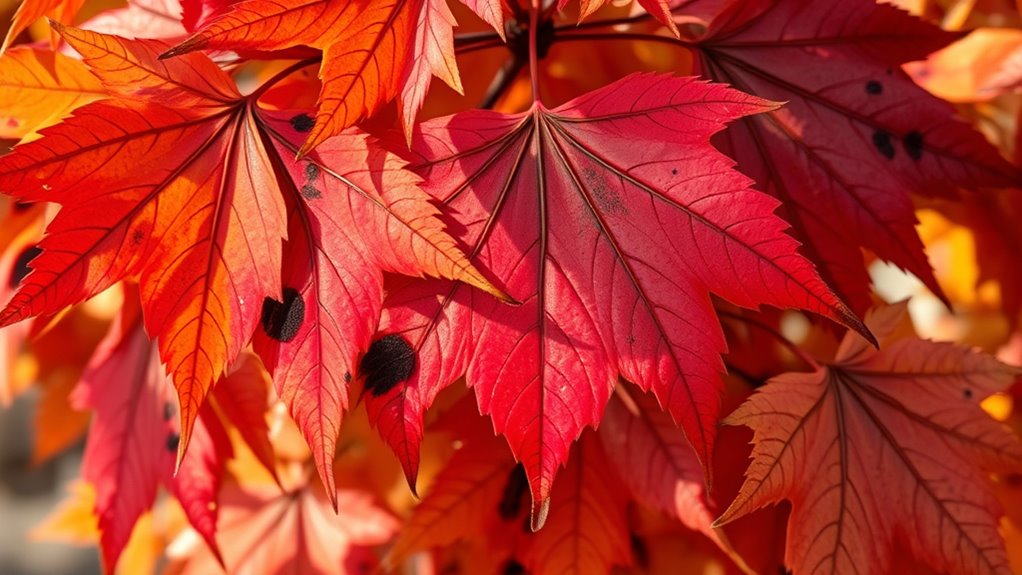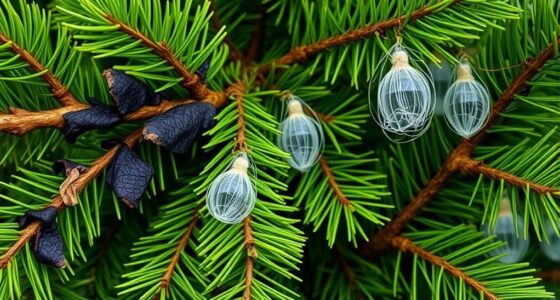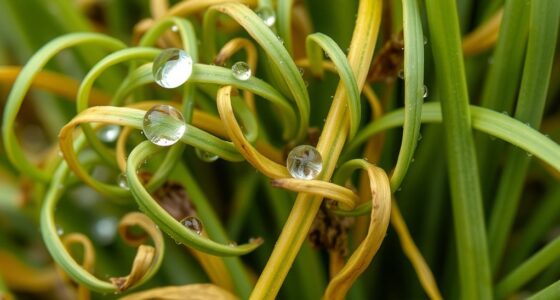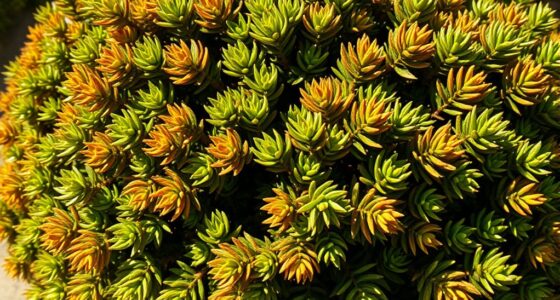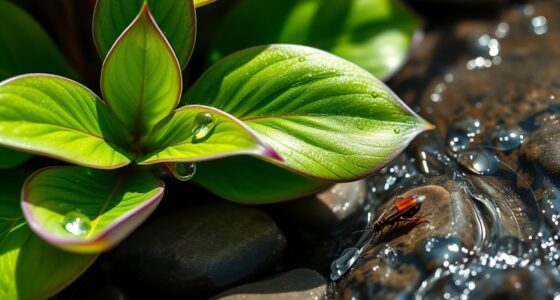If your Autumn Blaze maple leaves turn brown, it could be due to drought stress or tar spot disease. Drought causes browning starting at the leaf edges as roots struggle to absorb water, while tar spot creates dark, raised spots with yellow halos that can merge. To determine the cause, observe the spread and appearance of the browning. Keep exploring to learn how to distinguish these issues and protect your tree effectively.
Key Takeaways
- Drought causes browning starting at leaf edges, spreading inward, often accompanied by wilting and dry soil signs.
- Tar spot manifests as dark, raised spots with yellow halos that merge into black patches, primarily on upper leaf surfaces.
- Drought-related browning tends to be uniform, whereas tar spot produces irregular, spotty browning patterns.
- Persistent drought weakens roots and leaves, while tar spot is a fungal disease that can be managed with leaf removal and fungicides.
- Regular inspection and soil moisture management help distinguish between drought stress and fungal infection in Autumn Blaze maples.
Recognizing the Symptoms of Drought Stress in Maples
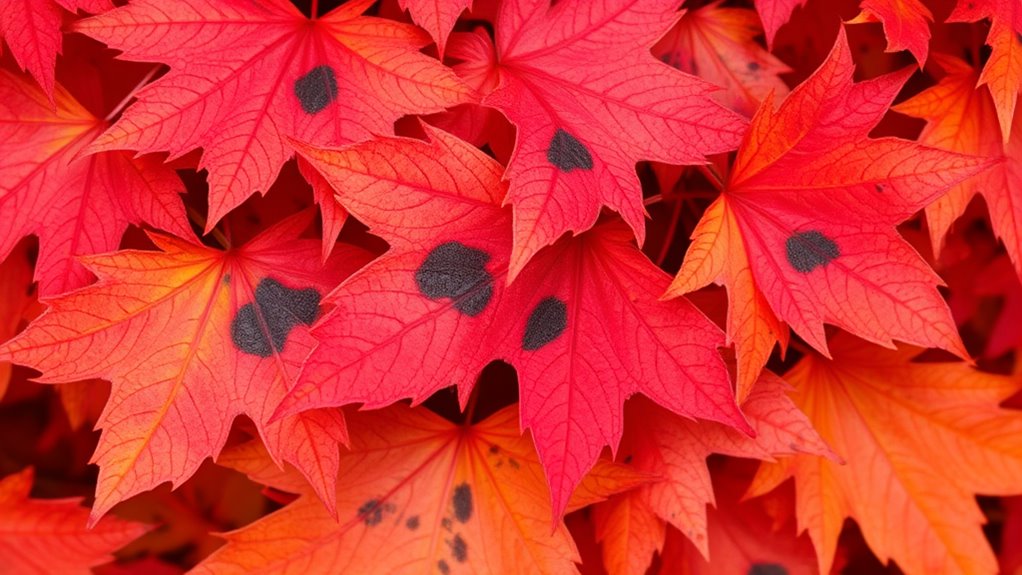
Drought stress can quickly diminish the health of your maple trees, often showing subtle signs before more severe damage occurs. One key indicator is declining soil moisture around your tree’s roots. When soil dries out, it hampers root health, making it harder for the tree to absorb water and nutrients. You might notice the leaves beginning to wilt or turn dull, even if the weather isn’t particularly hot. The roots may become weak or damaged if drought persists, leading to further stress. Checking soil moisture regularly can help you catch these early signs. If the soil feels dry a few inches below the surface, it’s a clear sign your tree needs watering. Incorporating proper insulation upgrades and ensuring your soil retains moisture can help mitigate drought effects. Maintaining optimal soil conditions is essential because soil moisture management directly influences tree resilience during dry periods. Ensuring proper ventilation and avoiding fire hazards around your trees can further protect them from additional stress factors during drought conditions. Prompt action can help restore root health and prevent more serious issues down the line.
Identifying Tar Spot Disease on Autumn Blaze Leaves
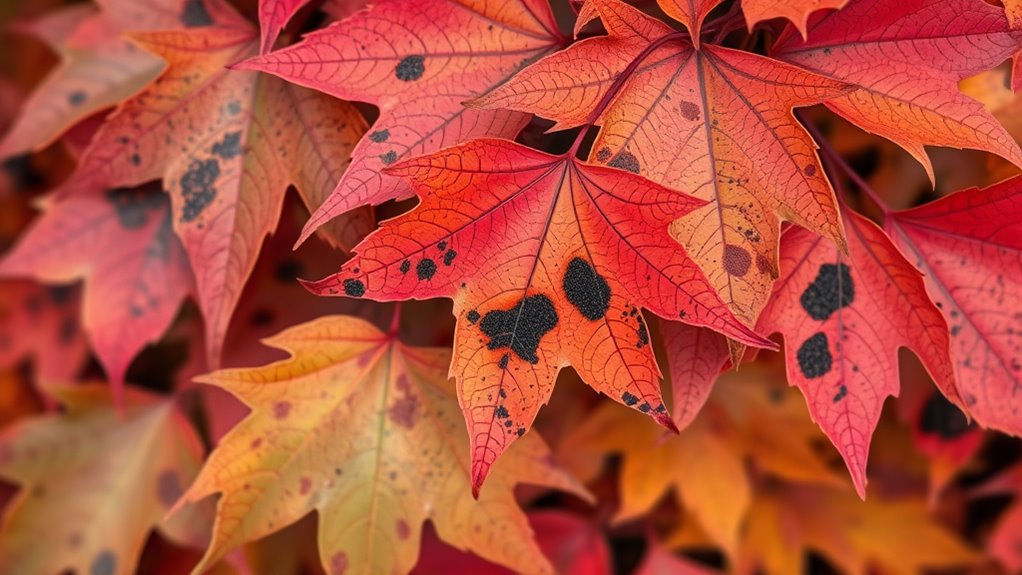
As you monitor your Autumn Blaze maple’s health, it’s important to be aware of specific leaf issues that may signal disease. One key sign of tar spot disease is distinctive leaf spotting. You’ll notice dark, raised spots appearing on the upper surfaces of the leaves, often bordered by a yellow halo. These spots can enlarge and merge, causing the leaf to develop black, irregular patches. Unlike normal fall color changes, these spots don’t enhance the tree’s visual appeal. Instead, they indicate a fungal infection that can weaken the leaf and cause premature leaf drop. Regularly inspecting your tree’s foliage for abnormal leaf spotting patterns helps you catch tar spot early and take appropriate action to protect your tree’s overall health. Proper disease identification techniques can help distinguish tar spot from other leaf issues. Using proper waste disposal methods for fallen leaves can also help prevent the spread of fungal spores.
Comparing Causes and Effects of Browning in Maple Trees
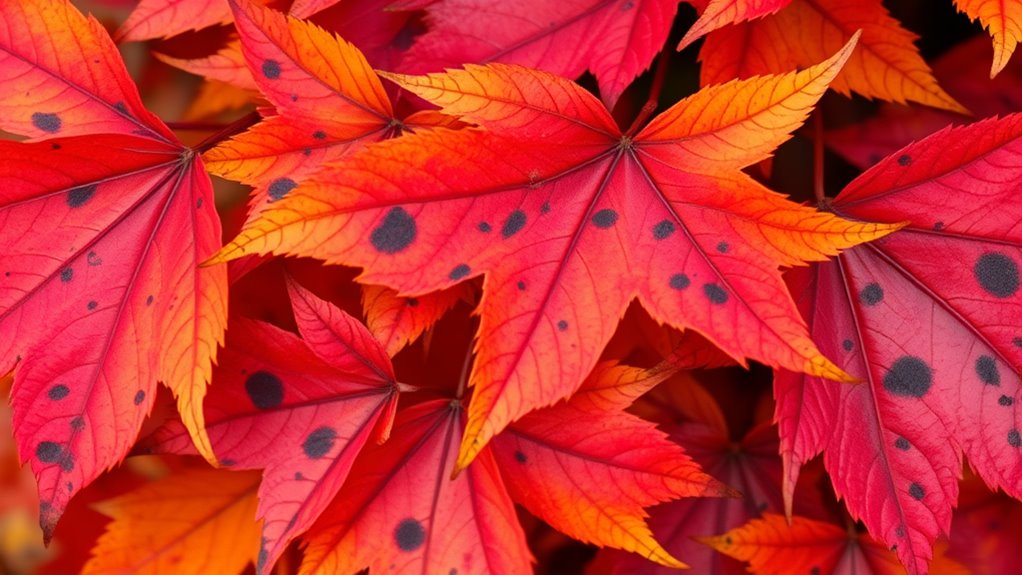
Browning in maple trees can result from a variety of causes, each with distinct effects on the tree’s health. One common cause is drought, which leads to reduced soil moisture. When soil moisture drops, your tree struggles to absorb water, causing leaf coloration to turn brown and crispy. This browning typically starts at the edges and spreads inward. Conversely, other issues like fungal infections may cause uneven or spotty browning, affecting leaf appearance differently. The effects of soil moisture imbalance are noticeable in overall leaf health and fall coloration, while fungal problems can cause localized damage. Understanding these differences helps you identify whether drought stress or disease is responsible for browning, allowing for appropriate measures to protect your maple’s health. Additionally, awareness of plant diseases can help in early detection and treatment of fungal infections that lead to browning. Recognizing signs of mindfulness can also assist in managing stress related to plant health issues and making informed care decisions.
Effective Strategies for Managing Drought and Fungal Infections
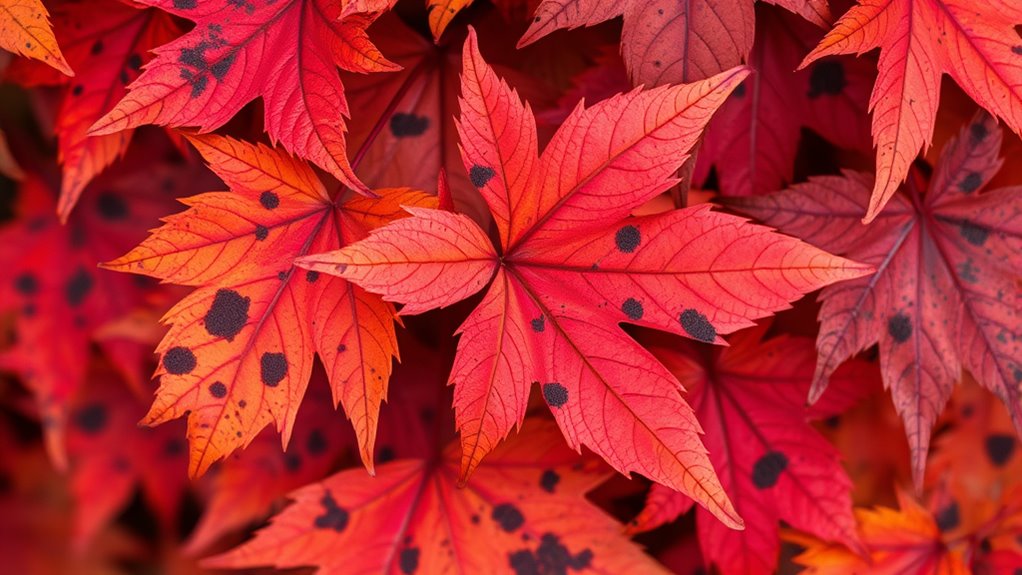
To effectively manage drought stress in your maple trees, guarantee they receive adequate water, especially during dry periods. Maintaining proper soil moisture is vital for tree health and helps prevent browning caused by drought. Deep watering encourages roots to grow deeper, improving drought resistance. Additionally, monitor your soil for nutrient deficiency, as lack of essential nutrients weakens trees and makes them more vulnerable to infections. Mulching around the base of the tree helps conserve moisture and regulate soil temperature. For fungal infections like tar spot, promptly remove fallen leaves to reduce spore spread. Applying appropriate fungicides, if recommended, can also help control fungal growth. Regular soil testing can identify specific deficiencies and guide targeted fertilization strategies. Incorporating integrated pest management practices can further protect your maple from various stressors and diseases. Being aware of tree health monitoring techniques can help detect early signs of stress and prevent severe damage.
Preventive Measures to Keep Your Maple Healthy During Fall
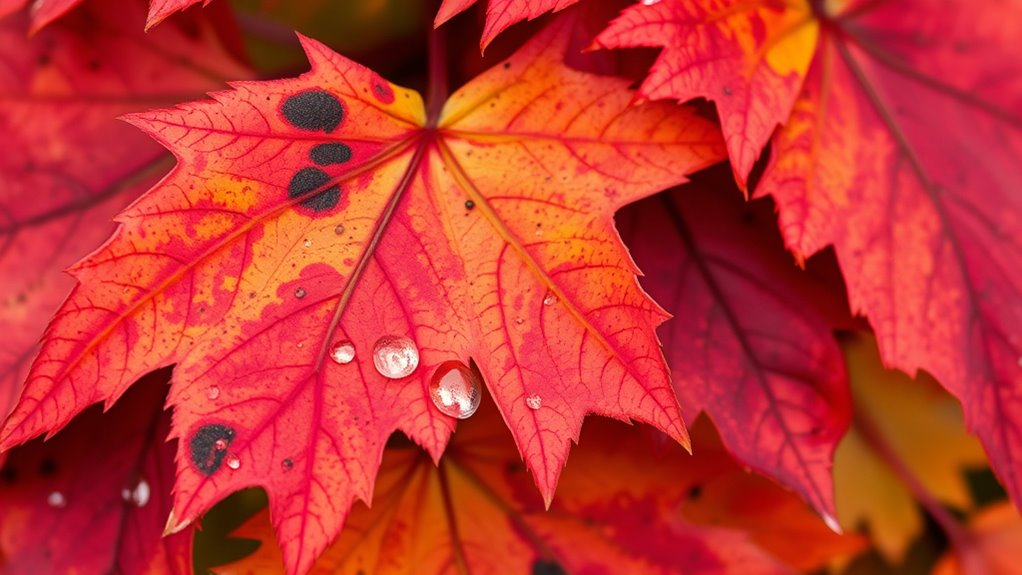
Preparing your maple tree for fall involves proactive steps to guarantee it stays healthy through the changing season. Start by applying soil amendments to improve drainage and nutrient availability, promoting strong root growth. Proper pruning techniques, such as removing dead or diseased branches, help prevent infections and improve airflow. This reduces the risk of fungal issues like tar spot and keeps leaves vibrant longer. Additionally, clear fallen leaves regularly to prevent disease buildup. Mulching around the base conserves moisture and stabilizes soil temperature. Regular inspections allow you to catch problems early, especially since understanding fungal issues is essential for effective prevention and treatment. Ensuring optimal color accuracy in your gardening practices can also help monitor changes in leaf coloration and health. Using the right air purifier technology can also help maintain a healthier environment around your trees by reducing airborne pathogens.
Frequently Asked Questions
Can Soil Type Influence Maple Leaf Color Changes During Autumn?
Soil type definitely influences your maple’s fall colors. If your soil has poor composition or low nutrient levels, your tree might struggle to produce vibrant hues, leading to dull or uneven leaf coloring. Healthy soil with balanced nutrients supports ideal chlorophyll breakdown and pigment development. So, by improving soil composition and ensuring proper nutrient levels, you can enhance the brilliance of your maple’s autumn display.
Are Certain Maple Varieties More Resistant to Drought or Tar Spot?
Some maple varieties show better disease resistance, making them more resilient against drought stress and tar spot. For example, certain cultivars are bred for drought tolerance, helping them maintain healthy foliage during dry periods. Others are less susceptible to tar spot, reducing leaf browning. When choosing a maple, consider its disease resistance and drought tolerance to guarantee it stays vibrant and healthy throughout the seasons.
How Does Pruning Affect the Tree’s Susceptibility to Browning?
Did you know that proper pruning can boost a tree’s resilience by up to 30%? Pruning techniques play a vital role in tree health management by removing diseased or dead branches, which can reduce stress and susceptibility to browning. When you prune correctly, you improve airflow and nutrient flow, helping the tree fight off issues like drought stress or tar spot. Always prune thoughtfully to support your tree’s long-term health.
What Role Do Environmental Pollutants Play in Leaf Discoloration?
Pollutant impact markedly contributes to leaf discoloration by introducing harmful chemicals that stress your trees. These pollutants, like ozone and sulfur dioxide, interfere with chlorophyll production, accelerating discoloration factors. You might notice premature browning or spotting, especially in urban areas with poor air quality. To protect your trees, consider reducing exposure to pollutants and maintaining tree health through proper watering and care, which can help mitigate the effects of environmental pollutants on leaf color.
Is There a Specific Time of Year Best for Treating Fungal Infections?
You should aim for fall treatment timing during the fungal control season, which typically occurs in late summer to early fall. Applying fungicides then helps prevent the spread of fungal infections as conditions become more humid and conducive to growth. By timing your treatments correctly, you give your trees the best chance to resist diseases, ensuring healthier foliage and vibrant fall colors. Act now to protect your landscape effectively.
Conclusion
To keep your Autumn Blaze maples vibrant this fall, stay vigilant for signs of drought stress and tar spot disease. Did you know that drought stress can reduce a tree’s growth by up to 50%? Regular watering, proper pruning, and fungicide treatments can make all the difference. By understanding these issues and taking proactive steps, you’ll enjoy those stunning, fiery leaves all season long. Your maples deserve the best care to thrive!
